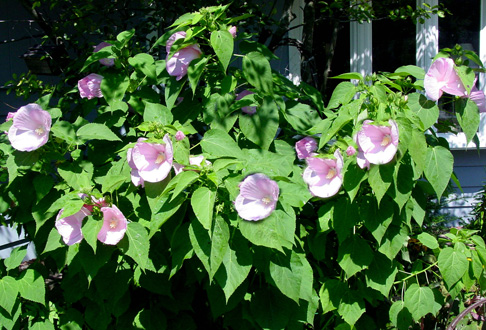A few years ago I planted a pink Hardy Hibiscus in our front garden. It was situated next to a small Hawthorne tree, but still got plenty of sun. That first year, my Hibiscus got at least 6 feet tall and had delicate blooms the size of saucers looking as if they were fashioned from crepe paper. It was so beautiful! Also, since it bloomed from mid-summer to frost, it looked good for a long time and was a great companion plant for all of my spring bulbs and iris. As the years have passed our little tree has gotten bigger and now the hibiscus lives in partial shade. Since I get fewer flowers in the shade, I plan to move the hibiscus to a sunnier area next year. Hopefully, it will survive the move, but if it doesn’t I am going to try one of the newer varieties. Perennial hibiscus flowers were once limited to red, white and pink. Not anymore – they now come in hot pink, mauve, rose, plum and bicolors and make great specimen plants.
Hardy hibiscus is an easy perennial to grow. I just fertilize it a bit each spring with composted cow manure and bone meal. Then in mid-summer, I do a second feeding. Also, I water during dry weather since hibiscus like to be kept consistently moist. Hardy hibiscus need a minimum of 6 hours of sun each day. They tolerate a wide range of soils but prefer a spot with a lot of organic matter and a slightly acidic pH. To increase organic matter and acidity at the same time, you can mix sphagnum peat moss into the planting soil.
One problem I do have with my perennial hibiscus is that it waits for warm weather and emerges so late in spring that it’s easy to accidentally dig it up. I got a great tip from my sister Mutsie to keep this particular disaster from happening. Her idea was to slip a flower pot with the bottom removed over the newly planted hibiscus and leave it in place over winter. That way, in spring, you always know your plant’s location and can avoid disturbing it.
The second problem I have is that the plants get so tall and heavy with their huge flowers that they often need staking. I have started using tomato towers to keep them upright. If you put towers on before the plants get too large, they grow into the space and the towers visually disappear while keeping the hibiscus contained and upright.
Research
While they do have woody stems, hibiscus plants die back to the ground each winter, so they are considered perennials. They are hardy to zone 4 and can survive in zone 3 with extra protection.




